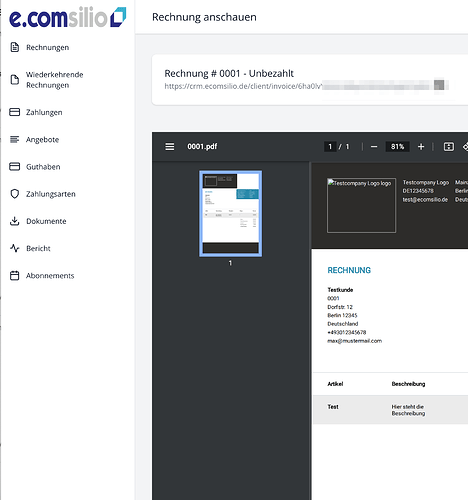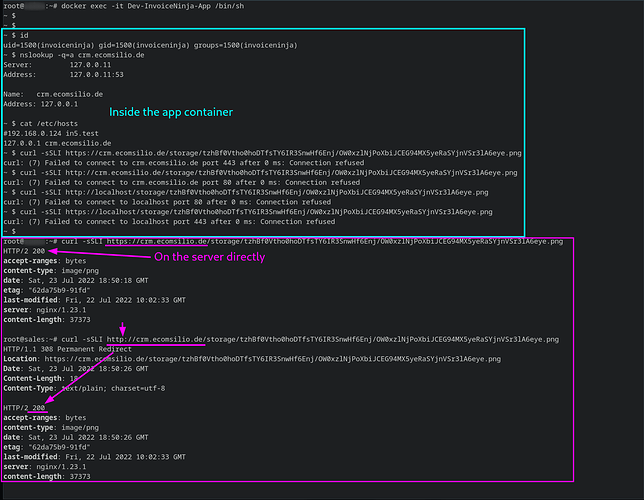Installation: Docker
Version: 5.4.1
I uploaded a logo but it is not being displayed at the invoices. When I preview an invoice or when I customize the invoice design, the logo is displayed as a broken image link.
When I customize the invoice design and toggl on “HTML Mode”, then the logo ist displayed correctly.
When I download the pdf, the logo is also missing.
Everytime the logo fails, there is the following error message in the browser console:
Mixed Content: The page at ‘https://crm.ecomsilio.de/#/’ was loaded over HTTPS, but requested an insecure XMLHttpRequest endpoint ‘Invoice Ninja’. This request has been blocked; the content must be served over HTTPS.
However, the logo is available via https: → Invoice Ninja
The logs do not show any errors. Here is the part where the logo is called via a GET call.
Dev-InvoiceNinja-Webserver | 2022-07-22T07:09:25.146641786Z 172.27.0.5 - - [22/Jul/2022:07:09:25 +0000] "POST /api/v1/preview HTTP/1.1" 200 130485 "https://crm.ecomsilio.de/" "Mozilla/5.0 (Macintosh; Intel Mac OS X 10_15_7) AppleWebKit/537.36 (KHTML, like Gecko) Chrome/103.0.0.0 Safari/537.36" "91.2.205.13"
Dev-InvoiceNinja-Webserver | 2022-07-22T07:09:26.876962536Z 2022/07/22 07:09:26 [warn] 32#32: *1 a client request body is buffered to a temporary file /var/cache/nginx/client_temp/0000000002, client: 172.27.0.5, server: _, request: "POST /api/v1/preview HTTP/1.1", host: "crm.ecomsilio.de", referrer: "https://crm.ecomsilio.de/"
Dev-InvoiceNinja-Webserver | 2022-07-22T07:09:29.550211642Z 172.27.0.5 - - [22/Jul/2022:07:09:29 +0000] "POST /api/v1/preview HTTP/1.1" 200 146190 "https://crm.ecomsilio.de/" "Mozilla/5.0 (Macintosh; Intel Mac OS X 10_15_7) AppleWebKit/537.36 (KHTML, like Gecko) Chrome/103.0.0.0 Safari/537.36" "91.2.205.13"
Dev-InvoiceNinja-Webserver | 2022-07-22T07:09:41.681100995Z 2022/07/22 07:09:41 [warn] 32#32: *1 a client request body is buffered to a temporary file /var/cache/nginx/client_temp/0000000003, client: 172.27.0.5, server: _, request: "POST /api/v1/preview?html=true HTTP/1.1", host: "crm.ecomsilio.de", referrer: "https://crm.ecomsilio.de/"
Dev-InvoiceNinja-Webserver | 2022-07-22T07:09:43.697852597Z 172.27.0.5 - - [22/Jul/2022:07:09:43 +0000] "POST /api/v1/preview?html=true HTTP/1.1" 200 25244 "https://crm.ecomsilio.de/" "Mozilla/5.0 (Macintosh; Intel Mac OS X 10_15_7) AppleWebKit/537.36 (KHTML, like Gecko) Chrome/103.0.0.0 Safari/537.36" "91.2.205.13"
Dev-InvoiceNinja-Webserver | 2022-07-22T07:09:43.911353011Z 172.27.0.5 - - [22/Jul/2022:07:09:43 +0000] "GET /storage/tzhBf0Vtho0hoDTfsTY6IR3SnwHf6Enj/muZDeSzJ471w6UjVO5a5KEMFfiPscJb8XdQIOvAj.png HTTP/1.1" 200 37373 "-" "Mozilla/5.0 (Macintosh; Intel Mac OS X 10_15_7) AppleWebKit/537.36 (KHTML, like Gecko) Chrome/103.0.0.0 Safari/537.36" "91.2.205.13"
Dev-InvoiceNinja-Webserver | 2022-07-22T07:09:53.902144877Z 172.27.0.5 - - [22/Jul/2022:07:09:53 +0000] "POST /api/v1/refresh?current_company=true&updated_at=1658471695&first_load=true HTTP/1.1" 200 176644 "https://crm.ecomsilio.de/" "Mozilla/5.0 (Macintosh; Intel Mac OS X 10_15_7) AppleWebKit/537.36 (KHTML, like Gecko) Chrome/103.0.0.0 Safari/537.36" "91.2.205.13"
Dev-InvoiceNinja-Webserver | 2022-07-22T07:10:17.732429277Z 172.27.0.5 - - [22/Jul/2022:07:10:17 +0000] "GET / HTTP/1.1" 200 4898 "-" "Uptime-Kuma/1.17.1" "94.31.104.167"
Dev-InvoiceNinja-Webserver | 2022-07-22T07:10:42.621265620Z 2022/07/22 07:10:42 [warn] 32#32: *1 a client request body is buffered to a temporary file /var/cache/nginx/client_temp/0000000004, client: 172.27.0.5, server: _, request: "PUT /api/v1/companies/VolejRejNm HTTP/1.1", host: "crm.ecomsilio.de", referrer: "https://crm.ecomsilio.de/"
Dev-InvoiceNinja-Webserver | 2022-07-22T07:10:42.729041202Z 172.27.0.5 - - [22/Jul/2022:07:10:42 +0000] "PUT /api/v1/companies/VolejRejNm HTTP/1.1" 200 16101 "https://crm.ecomsilio.de/" "Mozilla/5.0 (Macintosh; Intel Mac OS X 10_15_7) AppleWebKit/537.36 (KHTML, like Gecko) Chrome/103.0.0.0 Safari/537.36" "91.2.205.13"
Dev-InvoiceNinja-Webserver | 2022-07-22T07:10:46.090808083Z 172.27.0.5 - - [22/Jul/2022:07:10:46 +0000] "PUT /api/v1/companies/VolejRejNm HTTP/1.1" 200 16101 "https://crm.ecomsilio.de/" "Mozilla/5.0 (Macintosh; Intel Mac OS X 10_15_7) AppleWebKit/537.36 (KHTML, like Gecko) Chrome/103.0.0.0 Safari/537.36" "91.2.205.13"
Dev-InvoiceNinja-Webserver | 2022-07-22T07:11:00.202763182Z 2022/07/22 07:11:00 [warn] 32#32: *1 a client request body is buffered to a temporary file /var/cache/nginx/client_temp/0000000005, client: 172.27.0.5, server: _, request: "PUT /api/v1/companies/VolejRejNm HTTP/1.1", host: "crm.ecomsilio.de", referrer: "https://crm.ecomsilio.de/"
Here is my env configuration:
# IN application vars
APP_NAME="ecomsilio client portal"
APP_ENV=production
APP_URL=https://crm.ecomsilio.de
APP_KEY=base64:xxxxxxxxxxx
APP_DEBUG=true
REQUIRE_HTTPS=true
PHANTOMJS_PDF_GENERATION=false
PDF_GENERATOR=snappdf
LOCAL_DOWNLOAD=true
IS_DOCKER=true
TRUSTED_PROXIES=*
EXPANDED_LOGGING=true
LOG_PDF_HTML=true
QUEUE_CONNECTION=database
and here is the docker-compose.yml
services:
db:
image: mysql:5
container_name: Dev-InvoiceNinja-Database
env_file: env
restart: always
volumes:
- ./docker/mysql/data:/var/lib/mysql:rw,delegated
networks:
- traefik_dev
app:
image: invoiceninja/invoiceninja:5
container_name: Dev-InvoiceNinja-App
env_file: env
restart: always
volumes:
- ./config/hosts:/etc/hosts:ro
- ./docker/app/public:/var/www/app/public:rw,delegated
- ./docker/app/storage:/var/www/app/storage:rw,delegated
depends_on:
- db
networks:
- traefik_dev
server:
image: nginx
container_name: Dev-InvoiceNinja-Webserver
env_file: env
restart: always
volumes:
- ./config/nginx/in-vhost.conf:/etc/nginx/conf.d/in-vhost.conf:ro
- ./docker/app/public:/var/www/app/public:ro
labels:
- "traefik.enable=true"
- "traefik.http.routers.dev-ninja-webserver-router.rule=Host(`crm.ecomsilio.de`)"
- "traefik.http.routers.dev-ninja-webserver-router.entrypoints=web"
- "traefik.http.routers.dev-ninja-webserver-router.entrypoints=websecure"
- "traefik.http.routers.dev-ninja-webserver-router.tls.certresolver=letsencrypt"
- "traefik.http.services.dev-ninja-webserver.loadbalancer.server.port=80"
depends_on:
- app
networks:
- traefik_dev
networks:
traefik_dev:
external: true
I have tried partisan optimize, storage:link etc. I have done all the tricks from this, this and this post.
What else can I check? Any tips or tricks? Any help is much appreciated.
Thanks a lot!
Gijs





